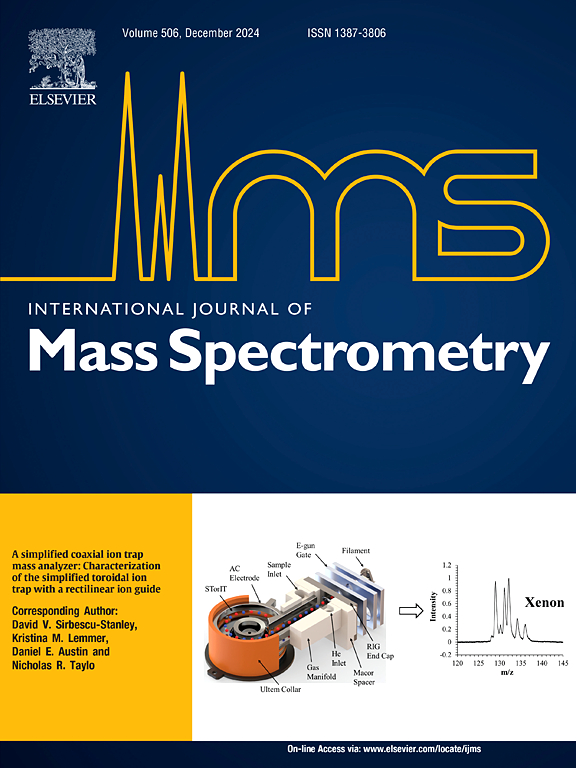Structural analysis of echinocandins via high-performance liquid chromatography-quadrupole/time-of-flight-tandem mass spectrometry
IF 1.7
3区 化学
Q3 PHYSICS, ATOMIC, MOLECULAR & CHEMICAL
引用次数: 0
Abstract
Herein, the structures of echinocandins were analyzed by high-performance liquid chromatography-quadrupole/time-of-flight-tandem mass spectrometry (HPLC-Q/TOF-MS/MS). The echinocandin components were separated by using a Diamonsil Plus C18 column (5 μm, 4.6 mm × 250 mm), with 0.1 % formic acid in water as mobile phase A and 0.1 % formic acid in acetonitrile as mobile phase B under gradient elution. A systematic strategy for the structural characterization of echinocandin B, which is the main component of echicandins, is presented based on the accurate molecular mass and diagnostic ions obtained from both adduct ions [M+H]+ and [M+Na]+ as precursor ions. In the three fragmentation pathways obtained from the precursor ion of [M+H]+, echinocandins and its fragment ions produced continuous dehydrated ions ([M-nH2O + H]+, n = 1, 2, 3, 4). The N-terminal fatty acyl (FA) connecting to the ornithine derivative transferred to the amino group of the proline derivative during fragmentation. Different characteristic ions, depending on the number of hydroxyls (0, 1, 2) on the ornithine derivative of different echinocandin analog. Moreover, the threonine residues underwent the neutral consecutive loss of acetaldehyde from the [M+Na]+ precursor ion. The [M+H]+ and [M+Na]+ echinocandin precursor ions respectively lost 1-(4-hydroxyphenyl)ethane-1,2-diol and 2-hydroxy-2-(4-hydroxyphenyl)acetaldehyde from the homotyrosine residues to generate different fragmentation ions. Thirteen echinocandin analogs were identified, including echinocandin C, echinocandin D, and echinocandin B variants with different FA and amino acid compositions.

高效液相色谱-四极杆/飞行时间串联质谱法分析棘白菌素的结构
采用高效液相色谱-四极杆/飞行时间串联质谱(HPLC-Q/TOF-MS/MS)分析棘白菌素的结构。采用Diamonsil Plus C18色谱柱(5 μm, 4.6 mm × 250 mm),以0.1%甲酸水溶液为流动相a, 0.1%甲酸乙腈为流动相B,梯度洗脱分离棘白菌素。本文基于[M+H]+和[M+Na]+加合离子作为前体离子获得准确的分子质量和诊断离子,提出了一种系统的表征棘白素B结构的策略。在由[M+H]+前体离子得到的3条破碎途径中,棘白菌素及其碎片离子产生连续的脱水离子([M- nh2o +H]+, n = 1,2,3,4)。连接鸟氨酸衍生物的n端脂肪酰基(FA)在断裂过程中转移到脯氨酸衍生物的氨基上。不同的特征离子,取决于羟基(0、1、2)的数目对不同棘白素类似物的鸟氨酸衍生物。此外,苏氨酸残基经历了[M+Na]+前体离子乙醛的中性连续损失。[M+H]+和[M+Na]+棘白菌素前体离子分别从同型酪氨酸残基中失去1-(4-羟基苯基)乙烷-1,2-二醇和2-羟基-2-(4-羟基苯基)乙醛,生成不同的断裂离子。鉴定出13种棘白菌素类似物,包括棘白菌素C、棘白菌素D和棘白菌素B,它们具有不同的FA和氨基酸组成。
本文章由计算机程序翻译,如有差异,请以英文原文为准。
求助全文
约1分钟内获得全文
求助全文
来源期刊
CiteScore
3.60
自引率
5.60%
发文量
145
审稿时长
71 days
期刊介绍:
The journal invites papers that advance the field of mass spectrometry by exploring fundamental aspects of ion processes using both the experimental and theoretical approaches, developing new instrumentation and experimental strategies for chemical analysis using mass spectrometry, developing new computational strategies for data interpretation and integration, reporting new applications of mass spectrometry and hyphenated techniques in biology, chemistry, geology, and physics.
Papers, in which standard mass spectrometry techniques are used for analysis will not be considered.
IJMS publishes full-length articles, short communications, reviews, and feature articles including young scientist features.

 求助内容:
求助内容: 应助结果提醒方式:
应助结果提醒方式:


